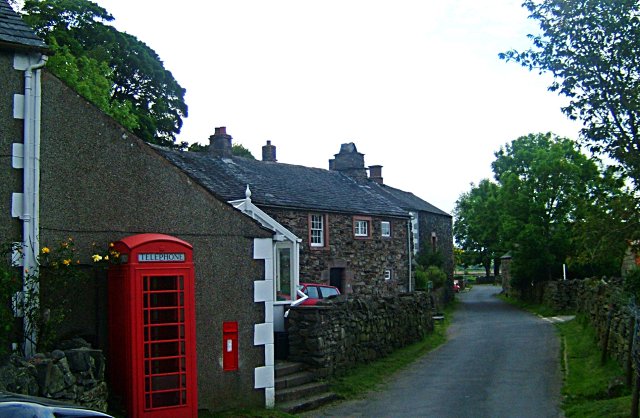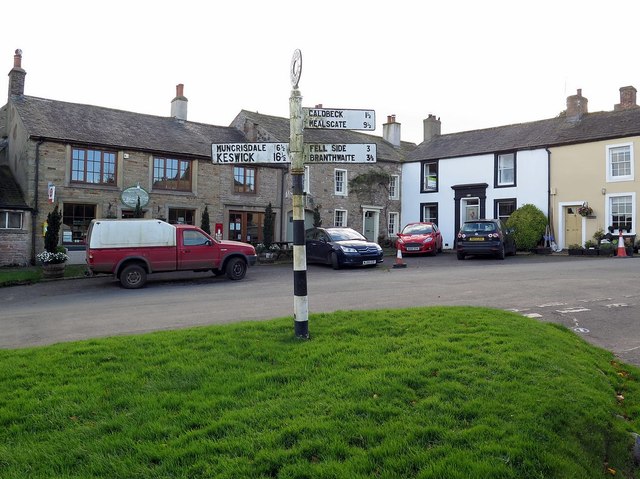Topics > Civil Parishes in Cumbria > Caldbeck Civil Parish > Caldbeck Parish, 1848
Caldbeck Parish, 1848
CALDBECK (St. Kentigern), a parish, in the union of Wigton, Allerdale ward below Derwent, W. division of Cumberland; containing 1,553 inhabitants, of whom 282 are in High, 646 in Low, and 567 in Haltcliffe, Caldbeck; 8 miles (S.E.) from Wigton. This parish comprises a mountainous tract of 18,000 acres, not more than 6,000 of which are inclosed, the remainder being appropriated to pasturing numerous flocks of sheep. The hills contain various mineral productions, principally lead and copper ores, limestone, and coal; and there are several establishments for working the mines: a considerable proportion of silver is occasionally extracted from the lead-ore. The river Caldbeck flows through the village, about half a mile from which, in a romantic glen called the Howk, where is a natural bridge of limestone, the stream dashes impetuously over rocks, and forms two interesting cascades, by the sides of which are singular excavations named the Fairies' Kirk and Fairies' Kettle. A manufactory for blankets, flannels, etc., has been long established; and there are a brewery, a small paper-mill, a fulling-mill, a gingham and check manufactory, and a dye-house. Hesket-Newmarket, in the division of Haltcliffe, is a smaller village, but more compact than Caldbeck, from which it is about a mile and a quarter distant to the east; it is situated on the south side of the river Caldew, which divides this parish from that of Castle-Sowerby. The living is a rectory, valued in the king's books at £45. 13. 6½.; net income, £436; patron, the Bishop of Carlisle. The church bears date 1112, and was founded soon after the establishment of an hospital for travellers, by the prior of Carlisle, with the permission of Ranulph D'Engain, chief forester of Inglewood: it stands in the township of Low Caldbeck, and was new roofed and greatly embellished in 1818. There are three meetinghouses for the Society of Friends, who settled here in the time of George Fox, their founder, who resided for some time at Woodhall; but their number, although formerly considerable, is now reduced to a few families. Robert Sewell, a natural philosopher of considerable repute, was a native of the parish.—See Hesket-Newmarket.
Extract from: A Topographical Dictionary of England comprising the several counties, cities, boroughs, corporate and market towns, parishes, and townships..... 7th Edition, by Samuel Lewis, London, 1848.

Co-Curate Page
Caldbeck
- Overview About Caldbeck Map Street View Caldbeck is a village in Cumbria, England, historically within Cumberland, it is situated within the Lake District National Park. The village had 714 …

Co-Curate Page
Mosedale (village)
- Overview About Mosedale Map Street View Mosedale is a small village at the foot of Carrock Fell in Cumbria. It is located 4 miles off the A66 road between Keswick …

Co-Curate Page
Hesket Newmarket
- Overview About Hesket Newmarket Map Street View Hesket Newmarket is a village in the Allerdale district of Cumbria, located by the River Calder, about 11 miles north-west of Penrith and …


Co-Curate Page
Caldbeck
- Overview About Caldbeck Map Street View Caldbeck is a village in Cumbria, England, historically within Cumberland, it is situated within the Lake District National Park. The village had 714 …

Co-Curate Page
Mosedale (village)
- Overview About Mosedale Map Street View Mosedale is a small village at the foot of Carrock Fell in Cumbria. It is located 4 miles off the A66 road between Keswick …








